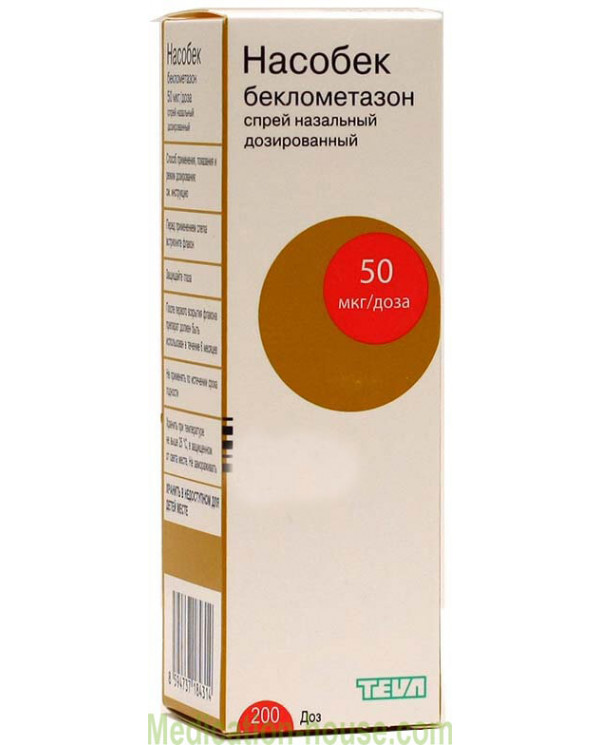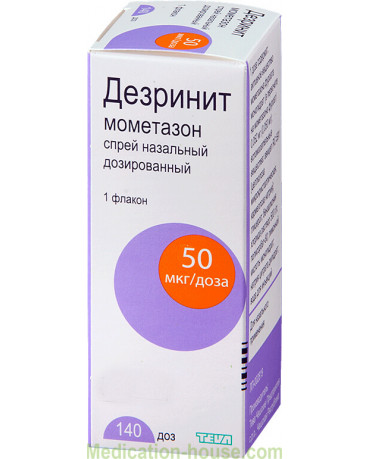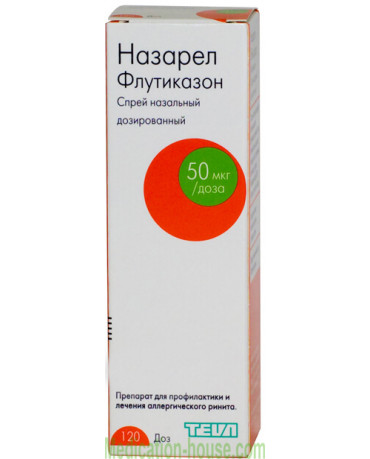Nasobec instruction
Reed more and buy Nasobec here
The main active ingredient of the pharmacological drug is beclomethasone dipropinate. It is allowed to use Nasobec both with seasonal and year-round allergies.
In addition to the antiallergic, the anti-inflammatory local effect on the human body also removes puffiness of the nasal mucosa.
Release form and composition
Nasobec is produced in the form of a metered nasal spray, which is a white opaque suspension that does not have any visible inclusions (200 doses each in plastic bottles with a mechanical metering applicator, in a cardboard bundle 1 bottle).
Active ingredient: beclomethasone dipropionate - 50 mcg in 1 spray dose.
Auxiliary components: 50% solution of benzalkonium chloride, polysorbate 80, dispersive cellulose (carmellose sodium + microcrystalline cellulose), phenylethanol, 35% hydrochloric acid, dextrose anhydrous, purified water.
Pharmacological effect
Nasobec has anti-inflammatory, anti-allergic and immunosuppressive effects. Increases the production of lipomodulin, which is an inhibitor of phospholipase A, inhibits the release of arachidonic acid.
It prevents the regional accumulation of neutrophils, reduces inflammatory exudation and production of lymphokines, inhibits the migration of macrophages, reduces the intensity of the processes of infiltration and granulation, the formation of chemotaxis substance. Reduces swelling of the nasal mucosa, mucus production. Improves mucociliary transport.
Indications for use
According to the instructions attached to Nasobec, the drug is indicated for use in the treatment and prevention of year-round and seasonal allergic rhinitis, as well as vasomotor (caused by nasal vegetative-vascular dysfunctions) rhinitis.
Contraindications for Nasobec
These include:
Tuberculosis;
Children under 6 years;
A history of viruses or fungi that multiply actively in the body;
Allergic reactions or intolerance to any of the components in the composition of the product;
Diathesis with a tendency to hemorrhage;
1 trimester of gestation;
Tendency to hemorrhages, bleeding from the nose, capillary fragility.
With caution, medication is prescribed for:
Glaucoma;
Cuts, ulcers and any damage to the nasopharynx;
Second and third trimesters during gestation;
After surgery in the nasal cavity or after recent trauma to the nasopharynx;
Hypothyroidism and iodine deficiency;
Myocardial infarction, recently suffered;
Breastfeeding;
Severe lesions of the liver and amebiasis.
Use during pregnancy and lactation
Use of the drug Nasobec is contraindicated in the first trimester of pregnancy. Use of the drug Nasobec in the II and III trimesters of pregnancy is allowed only if the expected benefit to the mother exceeds the possible risk to the fetus.
To use the drug Nasobec during the breastfeeding period should be with caution.
Dosage and method of use
The instructions for use indicated that Nasobec used intranasally.
Children between the ages of 6 and 12 are prescribed in an initial dose of 50 µg (1 dose) in each nasal passage 2 times / day, if necessary - 100 µg (2 doses) in each nasal passage 2 times / day. The maximum daily dose is 400 micrograms. The daily dose can be divided into 2-4 doses.
Adults and children over 12 years old are prescribed 50-100 mcg (1-2 doses) in each nasal passage 2 times / day; the daily dose is 200-400 mcg. The maximum daily dose is 400 micrograms. The daily dose can be divided into 2-4 doses.
When a therapeutic effect is achieved, the drug is canceled, gradually reducing the dose.
Elderly patients dose adjustment is not required.
Terms of use of the drug
When using for the first time, the spraying mechanism should be unlocked: press the dispenser several times until the aerosol cloud appears. If the drug has not been used for several days, the spraying mechanism should be unlocked again.
Clear nasal passages;
Shake the bottle, then remove the cap;
Place the bottle in the palm so that its bottom rests on the thumb, and the middle and index fingers rest on both opposite sides of the lower part of the nasal applicator;
Press the dispenser several times until an aerosol cloud appears (this procedure must be carried out before the first use and repeated in cases of a long interruption in the use of the drug);
Make a slight exhalation through the nose;
To pinch the nasal passage with a finger, in which the drug will not be injected;
Insert the applicator into the free nostril;
Slightly tilt the head so that the vial is in a perpendicular position;
Inject the aerosol dose by pressing the applicator and at the same time slightly inhaling the open nasal passage;
Exhale through the mouth;
If necessary, enter the second dose in the manner described;
A similar procedure is repeated with the second nostril;
Clean the upper (end) part of the applicator with a clean cloth and close the cap.
The nasal applicator should be cleaned at least 1 time per week to prevent the possibility of clogging. To do this, slightly press the bottom of the applicator and disconnect the nasal applicator. Rinse the applicator and cap with warm water and allow to dry. After that, put the applicator and cap back on the bottle.
Side effects
The following side effects may develop during the use of Nasobec (≥10% - very often; ≥1% and <10% - often; ≥0.1% and <1% - infrequently; ≥0.01% and <0.1% - seldom; <0.01% - very rarely, including isolated cases; with an unknown frequency - with insufficient data necessary to estimate the frequency of development of disorders):
Allergic reactions: rarely - urticaria, skin rash, angioedema;
Nervous system: rarely - dizziness, drowsiness, disturbance of taste and smell, headache;
Organ of vision: with unknown frequency - conjunctival hyperemia, increase in intraocular pressure, including glaucoma, cataracts (with prolonged therapy), decrease in vision;
Respiratory system: rarely - sneezing, irritation and dryness of the nasopharynx, burning, rhinorrhea, nasal congestion, atrophy of the nasal mucosa, nosebleeds, coughing; very rarely - perforation of the nasal septum (as a rule, in patients who had earlier undergone surgery in the nasal cavity), ulceration of the nasal mucosa;
Other: rarely - myalgia, candidiasis of the upper respiratory tract and oral cavity (with prolonged therapy and / or use in high doses (more than 0.4 mg per day); with an unknown frequency - with prolonged therapy may decrease the growth rate in children, the development of adrenal failure, decrease in bone mineral density.
Overdose
Symptoms: With prolonged use in high doses, as well as with the simultaneous reception of other (systemic) GCS, symptoms of hypercorticism may appear.
Treatment: the use of the drug should be discontinued, gradually reducing the dose.
special instructions
Before you start using the drug, read the specific instructions:
With prolonged use of the drug Nasobec in children, it is necessary to control the dynamics of their growth.
Patients with a high risk of developing adrenal insufficiency will need medical supervision.
Patients should be warned about the need to be careful and avoid contact with the drug Nasobec.
The therapeutic effect of the drug Nasobec, in contrast to the local vasoconstrictor drugs for the treatment of rhinitis, with intranasal use is not immediately apparent. Relieving the symptoms of rhinitis usually becomes noticeable after 5-7 days from the start of the drug. When a therapeutic effect is achieved, the dose of Nasobec should be reduced to the minimum effective dose controlling the course of the disease.
Benzalkoniya chloride contained in the preparation Nasobec, with prolonged use increases the risk of edema of the nasal mucosa. If a similar reaction occurs, a dose adjustment of Nasobec or the use of a drug that does not contain benzalkonium chloride is necessary.
Since the drug slows down the healing of wounds, patients with ulceration of the nasal septum, after surgical interventions in the nasal cavity, nasal injuries, should not use Nasobec until the wounds are fully healed.
Due to the fact that the use of the drug Nasobec may develop drowsiness and dizziness, patients should be careful when driving and occupations of potentially hazardous activities that require high concentration of attention and psychomotor reactions.
Drug interactions
When using the drug, you must consider the interaction with other drugs:
When combined, methandrostenolone, estrogens, beta2-adrenomimetics, theophylline, GCS for oral administration increase the effect of beclomethasone.
When combined, Nasobec enhances the effect of beta adrenomimetics.
With the combined use of phenobarbital, phenytoin, rifampicin reduce the effectiveness of beclomethasone (induction of microsomal oxidation enzymes).
Reviews about Nasobec
We picked up some reviews of people who used the drug Nasobec:
Anatoly
Hello everyone, I want to share what helped me for more than 30 years I suffer from rennit nose without drops. three days there comes a recovery, it helps better than oneself, just supper, but now I cannot find it, there are no analogues anywhere in pharmacies, but I want a proven drug that really helps.
Oksana
The doctor wrote him out to me when I had already tried all possible means to get rid of a cold. For half a year, she suffered from a cold, and as a result, she was diagnosed with vasomotor rhinitis. The drug is hormonal, anti-inflammatory, removes mucosal edema. The effect of the spray felt for 2 weeks of use. I did not observe any side effects of the drug, the spray did not cause addiction.
Anton
More than a year suffered from nasal congestion. Only galasoline-type vasoconstrictor remedies helped. Antiallergic drugs in tablets, as well as cromohexal, etc. had no success. After two days of taking Nasobec I felt relief, and on the fifth day I breathed freely both day and night. Three weeks have passed, I use nosabek daily, morning and evening, and I am afraid to stop. The instructions say that when a therapeutic effect is achieved, the drug is gradually canceled. Well, so what. I will cancel. Let's see how long his action will last ...
Storage conditions and shelf life
Store the drug should be at a temperature of 10 to 25 ° C, out of reach of children. The shelf life of the spray from the date of issue is 4 years, if the bottle has already been opened, the drug is allowed to use no more than 3 months.
Terms of sell
You can buy Nasobec without a prescription.



